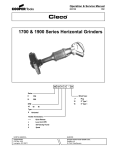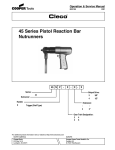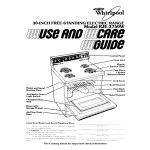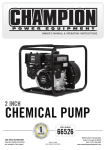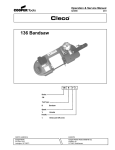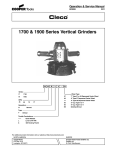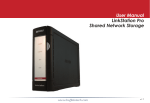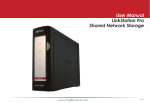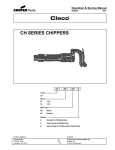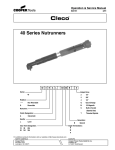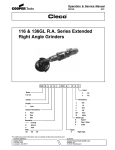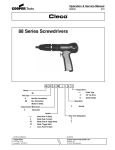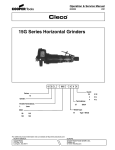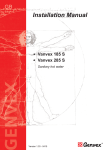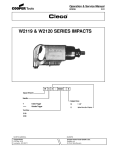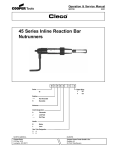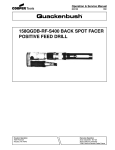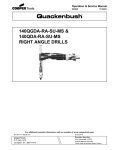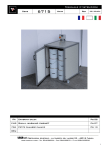Download warning - Apex Power Tools
Transcript
Operation & Service Manual 823038 2/01 15 Series Right Angle Grinders 15 G L - XX A - X 5T 7 Guard: Series: 7 15 7 In. Terminations: Grinder: 5T 5/8-11 Wheel Type: D Type 27 W Type 1 Wheel Throttle Terminations: L Lever RPM: 60 85 77 Model: A Right Angle For additional product information visit our website at http://www.clecotools.com NORTH AMERICA CooperTools P.O. Box 1410 Lexington, SC 29071 EUROPE Cooper Power Tools GmbH & Co. Postfach 30 D-73461 Westhausen 1 Safety Recommendations For your safety and the safety of others, read and understand the safety recommendations before operating any grinder. Always wear protective equipment and clothing. ! WARNING Impact resistant eye protection must be worn while operating or working near this tool. Caution: Faceshields do not provide unlimited protection against flying particles and are not to be considered as eye protection. ANSI Z87.1 states that separate eyewear shall be used. For additional information on eye protection, refer to Federal OSHA Regulations, 29 CFR, Section 1910.133, Eye and Face Protection, and ANSI Z87.1, Occupational and Educational Eye and Face Protection. This standard is available from the American National Standards Institute, Inc., 11 West 42nd Street, New York, NY 10036. ! ! WARNING Wear respirator where necessary. Grinding or other use of this tool may produce hazardous fumes and/or dust. To avoid adverse health effects utilize adequate ventilation and/or a respirator. Read the material safety data sheet of any materials involved in the grinding process. Cleco grinders are designed to operate on 90 psig (6.2 bar) max. air pressure. If the tool is properly sized and applied, higher air pressure is unnecessary. Excessive air pressure increases the loads and stresses on the tool parts and may result in breakage. Installation of a filter-regulator-lubricator in the air supply line is highly recommended. Never use the air hose for supporting, lifting, or lowering the tool. Use a safety line or cable on the tool when working in elevated areas. CAUTION Before tool is connected to air supply, check throttle for proper operation, i.e., throttle moves freely and returns to closed position. Being careful not to endanger adjacent Personal hearing protection is personnel, clear air hose of accumulated dust and moisrecommended when operating ture. Use protective barriers where necessary — hot sparks or working near this tool. can burn. Barriers also help reduce noise levels. Before removing tool from service or changing accessories, make Hearing protection is recommended in high noise areas sure air line is shut off and drained of air to prevent the tool (above 85 dBA). Close proximity of additional tools, reflec- from operating if the throttle is accidently engaged. The use tive surfaces, process noises, and resonant structures can of a self-relieving valve for this purpose is highly recomsubstantially contribute to the sound level experienced by mended. the operator. Proper hearing conservation measures, including annual audiograms and training in the use and fit of hearing protection devices may be necessary. For additional information on hearing protection, refer to Federal OSHA Regulations, 29 CFR, Section 1910.95, Occupational Noise Exposure, and American National Standards Do not operate without proper wheel guard in place. Institute, ANSI S12.6, Hearing Protectors. ! • Gloves and other protective clothing should be worn as required. • Do not wear clothing that may restrict movement, become entangled or in any way interfere with the safe operation of grinders. 2 WARNING The wheel guard is designed to prevent serious injury to the operator in the event of wheel failure and must not be modified in any way. Any wheel guard that is damaged or bent must be replaced. NOTE: The grinder must be held so that the opening in the guard is away from the operator. Safety Recommendations The guard must be securely attached to the grinder with all bolts, nuts and lockwashers in place and torqued to 30 - 40 in. lbs.. 0 • Dropping, bumping, or abuse (careless handling of the grinder or wheel) • Improper mounting • Imbalance • Improper shipment or storage • Exposure to water, solvents, high humidity, freezing and extreme temperatures • Mismatched speed ratings • Age 1 2 3 6 4 5 202408 WARNING AND INSTRUCTION LABEL WARNING ! OVER Repetitive work motions and/or vibration can cause injury to hands and arms. Use minimum hand grip force consistent with proper control and safe operation. Keep body and hands warm and dry. Avoid anything that inhibits blood circulation. Avoid continuous vibration exposure. Keep wrists straight. Avoid repeated bending of wrists and hands. CAUTION Personal hearing protection is recommended when operating or working near this tool. WARNING Hearing protection is recommended in high noise areas (above 85 dBA). Close proximity of other tools, reflective surfaces, process noises, and resonant structures can substantially contribute to the sound level experienced by the user. ! ! Impact resistant eye protection must be worn while operating or working near this tool. MODEL SERIAL NO. Cleco Read Operating Instructions carefully. Follow the Safety Recommendations for your safety and the safety of others. CAUTION Do not remove this tag until the operator of this tool has read these safety precautions. 869974 WARNING TAG The speed rating, warning tags and warning labels should be maintained or replaced for legibility in the event of damage. Speed rating, warning tags, and warning labels are available from the manufacturer. Before mounting a wheel, after all tool repairs, and whenever a grinder is issued for use, check the free speed of the grinder with a tachometer to make certain that the actual free speed at 90 psig (6.2 bar) does not exceed the rated free speed stamped on the tool. Grinders in use on the job must be similarly checked at least once every twenty hours of operation, or once every week, whichever is more frequent. Checking free speed after the removal of each worn wheel and before mounting a new wheel is highly recommended. INSPECT THE GRINDING WHEEL! Check the maximum safe RPM marked on the wheel. Never use a wheel rated below the actual tool speed. Inspect the wheel for cracks or chips, water stains, or signs of abuse or improper storage. Cracked, chipped or faulty grinding wheels are dangerous and must not be used . They must be destroyed rather than risk their use by someone who may not notice that they are damaged. ! Causes of abrasive wheel failures have been traced to such factors as: WARNING Fragments from an abrasive wheel can cause serious injury or death. Do not operate without proper wheel guard in place. Abrasive wheels known to have been subjected to any of the above conditions can burst violently. Never operate a right angle grinder without proper wheel guard in place. CHECK FLANGE Check the grinder spindle and driving flange for signs of damage or abuse. On a vertical grinder the driving flange must be flat, unrelieved, and free of nicks and burrs. The spindle must not be bent and the threads should be free of any damage that might keep an abrasive wheel and its mount from locating centrally or seating properly against the driving flange. ABRASIVE WHEEL MOUNTING & BEGINNING GRINDING OPERATION Tighten wheels to a minimum of 10 ft. lbs. (13.6Nm) to prevent wheel spin off. Do not over-tighten. Before beginning operations or after mounting a wheel, the tool must be run for one (1) minute in a protected enclosure to check the integrity or the wheel. During this time or any other time, no one should stand in front of or in line of the wheel. When starting work with a cold wheel, apply it gradually to the workpiece until the wheel becomes warm. DO NOT CONTINUE TO USE A GRINDER IF: • It is not equipped with the proper wheel guard • The speed rating of the wheel is less than the speed of the grinder • It starts to vibrate • You sense any changes in tool speed or an unusual increase in noise output that would indicate the tool is running at excessive speed • You notice excessive end play in the spindle • You hear any unusual sound from the grinder RETURN THE TOOL TO THE TOOL CRIB FOR SERVICE IMMEDIATELY! 3 Safety Recommendations ! WARNING Repetitive work motions and/or vibration can cause injury to hands and arms. Use minimum hand grip force. Keep body and hands warm and dry. Avoid anything that inhibits blood curculation. Avoid continuous vibration exposure. Keep wrists straight. Avoid repeated bending of wrists and hands. Some individuals may be susceptible to disorders of the hands and arms when performing tasks consisting of highly repetitive motions and/or exposure to extended vibration. Cumulative trauma disorders such as carpal tunnel syndrome and tendonitis may be caused or aggravated by repetitious, forceful exertions of the hands and arms. Vibration may contribute to a condition called Raynaud's Syndrome. These disorders develop gradually over periods of weeks, months, and years. It is presently unknown to what extent exposure to vibrations or repetitive motions may contribute to the disorders. Hereditary factors, vasculatory or circulatory problems, exposure to cold and dampness, diet, smoking and work practices are thought to contribute to the conditions. Any tool operator should be aware of the following warning signs and symptoms so that a problem can be addressed before it becomes a debilitating injury. Any user suffering prolonged symptoms of tingling, numbness, blanching of fingers, clumsiness or weakened grip, nocturnal pain in the hand, or any other disorder of the shoulders, arms, wrists, or fingers is advised to consult a physician. If it is determined that the symptoms are job related or aggravated by movements and postures dictated by the job design, it may be necessary for the employer to take steps to prevent further occurrences. These steps might include, but are not limited to, repositioning the workpiece or redesigning the workstation, reassigning workers to other jobs, rotating jobs, changing work pace, and/or changing the type of tool used so as to minimize stress on the operator. Some tasks may require more than one type of tool to obtain the optimum operator/tool/task relationship. The following suggestions will help reduce or moderate the effects of repetitive work motions and/or extended vibration exposure: • Use a minimum hand grip force consistent with proper control and safe operation • Keep body and hands warm and dry (cold weather is reported to be a major factor contributing to Raynaud's Syndrome) • Tasks should be performed in such a manner that the wrists are maintained in a neutral position, which is not flexed, hyperextended, or turned side to side 4 • Avoid anything that inhibits blood circulation —Smoking Tobacco (another contributing factor) —Cold Temperatures —Certain Drugs Avoid Extension OK Neutral Avoid Flexion Avoid Radial Deviation OK Avoid Neutral Ulnar Deviation • Stressful postures should be avoided — select a tool appropriate for the job and work location • Avoid highly repetitive movements of hands and wrists, and continuous vibration exposure (after each period of operation, exercise to increase blood circulation) • Use quality abrasive wheels • Keep tool well maintained and replace worn parts Work gloves with vibration reducing liners and wrist supports are available from some manufacturers of industrial work gloves. Tool wraps and grips are also available from a number of different manufacturers. These gloves, wraps, and wrist supports are designed to reduce and moderate the effects of extended vibration exposure and repetitive wrist trauma. Since they vary widely in design, material, thickness, vibration reduction, and wrist support qualities, it is recommended that the glove, tool wrap, or wrist support manufacturer be consulted for items designed for your specific application. WARNING! Proper fit of gloves is important. Improperly fitted gloves may restrict blood flow to the fingers and can substantially reduce grip strength. USE QUALITY ABRASIVE WHEELS The primary source of vibration when using a portable grinder is an abrasive wheel that is out of balance, out of round, untrue, or possibly any combination of all three. The use of quality abrasive wheels which are well balanced, round, and true is highly recommended as they have been found to significantly reduce vibration. Some abrasive wheels lose their balance, roundness, and trueness as they wear from use. Because of the abusive nature of the vibration caused by out of balance, out of round, and untrue condition of some abrasive wheels, it is felt that these wheels are more susceptible to failure. Excessive vibration may signal eminent wheel failure. Flat spotting of the abrasive wheel, caused by grinding the wheel to a stop after the power has been shut off can result in changes to the balance and shape of the wheel. Be sure the grinding wheel has stopped before setting the tool down. Set the tool in a tool rest or tool holder when not in use. Safety Recommendations WIRE BRUSHES PROPER LUBRICATION If a grinder is used for wire brushing applications the same problems of balance, roundness, and trueness as experienced with abrasive wheels prevail. Use quality wire brushes. An automatic in-line filter-regulator-lubricator is recommended as it increases tool life and keeps the tool in sustained operation. The in-line lubricator should be regularly checked and filled with a good grade of 10W machine oil. Proper adjustment of the in-line lubricator is performed by placing a sheet of paper next to the exhaust ports and holding the throttle open approximately 30 seconds. The lubricator is properly set when a light stain of oil collects on the paper. Excessive amounts of oil should be avoided. Wire brushes must be kept clean and stored properly to prevent bending damage and corrosion. Excessive bending of wires during brushing causes breakage and flying wires. Wear full face protection, use guard, and exercise caution. STORAGE USE A PREVENTIVE MAINTENANCE PROGRAM Tool abuse or poor maintenance procedures can amplify and contribute to the vibration produced by the abrasive wheel. A preventive maintenance program featuring scheduled periodic inspections and proper maintenance is the best way to assure safety in your portable grinding operations. A well managed program can, for example, detect such things as speed variations due to wear, flanges or spindles that have been damaged from abuse, or bad bearings damaged by foreign matter or lack of lubrication. Problems such as these can affect the wheel trueness when the grinder is running and contribute to the vibration. Rotor blades that are worn or chipped can lock up motor and result in grinding wheel spinoff and should be replaced. Rotor blades should be checked periodically and replaced if they measure less than 7/32" (5.5mm) at either end. Must be replaced if 7/32" (5.6mm) or less at either end. Proper repair procedures and the use of original Cleco service parts and bearings rather than substitutes will return the tool to factory specifications of precision and balance, and minimize vibration. In the event that it becomes necessary to store the tool for an extended period of time (overnight, weekend, etc.), it should receive a generous amount of lubrication at that time and run for several seconds to distribute the oil before disconnecting from the air supply. This will reduce the possibility of corrosion and displace any water that may be trapped in the tool. Water trapped in the tool could cause the governor to freeze and malfunction if tool is exposed to freezing temperatures. Note: Water in the air system increases tool maintenance costs and can cause the tool to malfunction when it is stored and/or operated in freezing conditions. This information is a compilation of general safety practices obtained from various sources available at the date of production. However, our company does not represent that every acceptable safety practice is offered herein, or that abnormal or unusual circumstances may not warrant or require additional procedures. Your work may require additional specific safety procedures. Follow these procedures as required by your company. For more information, see the latest edition of ANSI B186.1, Safety Code for Portable Air Tools, and ANSI B7.1 Safety Requirements for the Use, Care, and Protection of Abrasive Wheels available from the American National Standards Institute, Inc., 11 West 42nd Street, New York, NY 10036. The governor should be checked periodically to be sure the governor mechanism is clean, in good operating condition, and functioning properly. If excessively worn govenor center No. 865687, weights No. 865663, or pins No. 867388, should be replaced. 5 TYPE 27 WHEEL GUARD MOUNTING MODEL SERIAL NO. Driving Flange 5/8 - 11 864382 Wheel Guard Retainer Bolt Nut Cleco CAUTION Flange Set Screw 5/8 - 11 843518 Flange Key Lock Washer Wheel Guard Retainer Bolt Spacer Depressed Center Wheel 3/8" Adapter Kit (Provides proper back 849269 support required for depressed center or raised hub wheels with 7/8" holes.) TYPE 27 PROPER GRINDING WHEEL MOUNTING MODEL SERIAL NO. 6 Cleco CAUTION Depressed Center Wheel 20 24 08 CAUTION LABEL 202408 Wheel Guard 7" 865986 CAUTION (If Required) Note: For wheels with built in disposable adapters. Spacers No. 843851 may be used to properly space the wheel within the guard. Spindle Flange Adapter Nut CAUTION Flange Set Screw Adapter Spacer (If Required) Proper Wheel Guard Note: For wheels with built in disposable adapters. Spacers No. 843851 may be used to properly space the wheel within the guard. -1 TYPE 1 WHEEL GUARD MOUNTING Wheel Guard Retainer Bolt Nut Type 1 Wheel Relieved Flanges 1/3 Dia. of Wheel Flange Dias. Equal Clean, no nicks or burrs MODEL SERIAL NO. Driving Flange 5/8 - 11 204129 Cleco CAUTION Flange Key Flange Set Screw 5/8 - 11 843518 Lock Washer Wheel Guard Retainer Bolt CAUTION LABEL 202409 Wheel Guard 7" 204131 Wheel Blotters Both Sides Outer Flange 5/8 - 11 204130 Spindle End Nut 5/8 - 11 843846 7 ACCESSORIES FOR 15GL-RA GRINDER DEPRESSED CENTER WHEEL GRINDING 843851 SPACER (IF REOUIRED) 849269 ADAPTOR KIT (7/8" PLAIN HOLE WHEELS) 865986 7" WHEEL GUARD SPIRAL COOL RUBBER SANDING PAD 849848 5" SPIRAL RUBBER PAD 849913 7" SPIRAL RUBBER PAD 849259 PAD NUT 849834 SPANNER WRENCH 843851 SPACERS (2 REQUIRED) OPERATING AND SERVICE INSTRUCTIONS READ SAFETY RECOMMENDATIONS BEFORE CONNECTING TOOL. The 15GL-RA Series Grinders are designed to operate on 90 psig (6.2 bar) maximum air pressure, using a 3/8" hose up to 8' in length. If additional length is required, the next larger hose size may be connectied to the 8' whip hose. LUBRICATION An automatic in-line filter- regulator- lubricator is recommended as it increases tool life and keeps the tool in sustained operation. The in-line lubricator should be regularly checked and filled with a good grade of 10W machine oil. Proper adjustment of the in-line lubricator is performed by placing a sheet of paper next to the exhaust ports and holding the throttle open approximately 30 seconds. The lubricator is properly set when a light stain of oil collects on the paper. Excessive amounts of oil should be avoided. Application of the tool should govern how frequently it is greased. It is recommended that the right angle gears receive a generous amount of Keystone 122-C5X grease when the angle head is removed for service. Periodic lubrication is recommended through grease fitting in head. 8 STORAGE In the event that it becomes necessary to store the tool for an extended period of time (overnight, weekend, etc.), it should receive a generous amount of lubrication at that time and again when returned to service. The tool should be stored in a clean and dry environment. DISASSEMBLY To disassemble the 15G-RA, unscrew the head (left hand threads) and slip the motor out of the backhead. See the following pages for disassembly instructions on the various subasemblies. REASSEMBLY If the tool has been completely disassembled, assemble the various sub-assemblies per their instructions. After assembly of the complete tool, the R. P. M. must be checked with a reliable tachometer. Check R.P.M. without wheel. Mount guard before installing abrasive wheel. 15GL-RA RIGHT ANGLE HEAD 843589 865647 .001 865648 .002 865649 .003 865696 865664 881393 861161 613674 .005 613685 .010 865524 .015 844773 865651 865665 842240 864383 865652 843518 865651 842517 865685 861161 204129 Type 1 7" Wheel 864382 Type 27 865650 619499 865644 SERVICE INSTRUCTIONS FOR RIGHT ANGLE HEAD DISASSEMBLY The bearing spacer, No. 865665, handle positioning spacers, No. 865524, and driving pinion with attached bearing, No. 844773, may be removed from the rear of the angle head, No. 865696. Loosen the set screw, No. 843518, and remove the spindle flange, No. 864382. Unscrewing the spindle retainer nut, No. 865652, (Left Hand Threads) will allow the spindle with attached components to be removed from the angle head. Using a suitable bearing puller, the bearings and driven gear may be removed from the spindle. REASSEMBLY The right angle head is reassembled in the reverse order of disassembly. All parts should be cleaned and inspected for wear or damage. All bearings and gears should receive a generous amount of Keystone 122-C5X grease. For proper spacing on the right angle gears, remove spacers until tooth interference is felt, then add a .001" gear spacer, No. 865647. Lever positioning spacers, Nos. 613674, 613675, and 865524, are used to position the backhead in relationship to the right angle head. PARTS LIST — 15GL-RA RIGHT ANGLE HEAD PART NO. 613674 613675 619499 842240 842517 843518 843589 844773 861161† 864382 864383 865524 865644 865647 865648 865649 NAME OF PART Handle Positlonlng Spacer (.005) Handle Positlonlng Spacer (.010) Lower Spindle Bearlng Spindle Gear Key Upper Spindle Bearlng Flange Set Screw Grease Fitting Driving Gear Bearing Bevel Gear Set Driving Flange Flange Key Handle Positioning Spacer (.015) Bearing Shield Gear Spacer .001 Gear Spacer .002 Gear Spacer .003 Qty. PART NO. * * 1 1 1 1 1 1 1 1 1 * 1 * * * 865650 865651 865652 865664 865665 865685 865696 881393 . NAME OF PART Felt Rlng Retalner Rlng Spindle Retalner Nut Exhaust Deflector Bearlng Spacer Spindle ( 5/8 -11) Right Angle Housing (Incl. 843589) Dead Handle Qty. The complete Right Angle Head can be purchased as a subassembly 5/8-11 Spindle — Code No. 861199. 1 2 1 1 1 1 1 1 * Number of Spacers required is variable. Additions to parts list for 7” Type 1 Wheel 204129 7” Type 1 Driving Flange 204130 7” Type 1 Outer Flange 1 1 PARTS NOT SHOWN 865986 204131 7" Depressed Center Wheel Guard 7” Type 1 Wheel Guard 1 1 † NOTE: 861161 Includes both Gears 9 15GL-RA MOTOR & GOVERNOR 847095 865691 RPM Part No. 6000 867082 7700 867083 8500 867084 865663 867388 865686 864821 865687 These parts 864821 are included in governor 867086 864234 864232 865663 867388 subassembly 865693 865661 865657 812164 Govenor center No. 865687, govenor weights No. 865663 and Pins No. 867388 should be checked 865658 864236 periodically for wear and SERVICE INSTRUCTIONS FOR 15G-RA MOTOR & GOVERNOR replaced when necessary. DISASSEMBLY Remove the retainer ring, No. 865661, and clamp the cylinder, No. 864236, in a soft jawed vise with the splined end of the rotor facing upward. Using a soft mallet, tap the rotor, No. 865691, out of the front rotor bearing, No. 865658. This will allow the front rotor bearing, front bearing plate, No. 865693, rotor collar, No. 865657, cylinder, and rotor blades. No. 864234 to be removed from the rotor. Lightly clamp the rotor in the vise and unscrew the governor (Left Hand Threads). The governor adjusting screw, No. 867086, may now be removed from the rear of the rotor by using a long series 3/32'' Hex wrench, No. 867027, from the front of the rotor. REASSEMBLY The motor is reassembled in the reverse order of disassembly. Wash all parts thoroughly in solvent and visually inspect for damage or wear. Check bearings for wear which can be detected by excessive end play, or roughness of the bearings which indicates a brinelled condition. Pack both rotor bearings with a good grade of NLGI 2-EP grease. Particular attention should be paid to the governor assembly, replacing any of its' parts that show wear or damage. It is PART NO. 812164 847095 864232 864234 864236 864821 865657 865658 865661 865663 recommended that new rotor blades be installed at each repair cycle. If not replaced, the used ones must measure a minimum of 7/32" (5.5mm) at both ends.Failure of these parts could cause damage to more expensive components. Also, be sure that the blades are no longer than the rotor. Must be replaced if 7/32" (5.6mm) or less at either end. The rotor in this tool must be set by means of the rotor collar, No. 865657, so that when assembled, there is .0015'' clearance between the front end of the rotor and the face of the front bearing plate. To properly set the rotor collar, assemble the front bearing (shield toward backhead) into the front bearing plate. Measure the depth of the inner race from the face of the bearing plate. Select, or fit by sanding, a rotor collar .0015'' larger than this dimension. The governor adjusting screw, No. 867086, should be inserted in the rotor with the hex toward the splined end of the rotor. It may be adjusted from the front of the motor with a long series 3/ 32'' Hex Wrench, No. 867027. PARTS LIST — 15GL-RA MOTOR AND GOVERNOR NAME OF PART QTY. PART NO. NAME OF PART 1 865686 Governor Spider* Cylinder Pin 1 865687 Governor Center* Rear Rotor Bearing Rear Bearinig Plate 1 865691 Rotor Rotor Blades 4 865693 Front Bearing Plate Cylinder 1 867082 Governor Spring — See Chart 2 867083 Governor Spring — See Chart Safety Lock Pin 1 867084 Governor Spring — See Chart Rotor Collar Front Rotor Bearing 1 867086 Governor Adj. Screw Front Bearing Retainer 1 867388 Governor Weight Pin* Governor Weight* 2 QTY. 1 1 1 1 1 1 1 1 2 The complete governor assembly can be purchased using Part No. 861176. *parts included in governor assembly. 10 15GL-RA HANDLE 202105 202106 869855 869856 843590 865698 847808 841552 863093 864375 864530 202337 844311 847710 865701 843590 844304 864387 832595 864531 SERVICE INSTRUCTIONS FOR 15GL-RA HANDLE DISASSEMBLY To disassemble the lever throttle handle, unscrew the throttle valve cap No. 864531. This will allow the complete throttle valve assembly to be removed from the handle. The oiler body on the handle may be removed from the front of the handle with the aid of spreaders. PART NO. 202105 202106 202337 832595 841552 843590 844304 844311 845409 847710 NAME OF PART Toggle Lock-Off Lever Throttle Valve Throttle Valve Spring Inlet Bushing Oiler Valve "O"-Ring 7/32' x 11/32" "O"-Ring 9/16" x 3/4" Toggle Pin "O"-Ring 1/2" x 5/8" REASSEMBLY The handle is reassembled in the reverse order of disassembly. All parts should be inspected for damage or wear. Should a throttle valve bushing need replacing, be sure that the air ports are aligned. Coat throttle valve bushing with Locktite #271 before pressing into position. Air screens should be cleaned and replaced if torn. PARTS LIST — 15GL-RA HANDLE QTY. PART NO. NAME OF PART 847808 Throttle Lever Pin 1 863093 "O"-Ring 1" x 1-1/8" 1 864375 Throttle Valve Seal 1 864387 Oil Fill Plug 1 Valve Bushing 864530 1 864531 Valve Cap 2 865698 Oiler Body (Incl.843590) 1 865701 Backhead (Incl.864530) 1 869855 Toggle Spring 1 1 QTY. 1 1 1 1 1 1 1 1 1 The complete handle assembly can be purchased using Part No. 201019. The lock-off lever can be purchased as a subassembly using Part No. 861992. 11 CooperTools 670 Industrial Drive Lexington, SC 29072 Phone: (803) 359-1200 Fax: (803) 359-2013 www.clecotools.com 12












